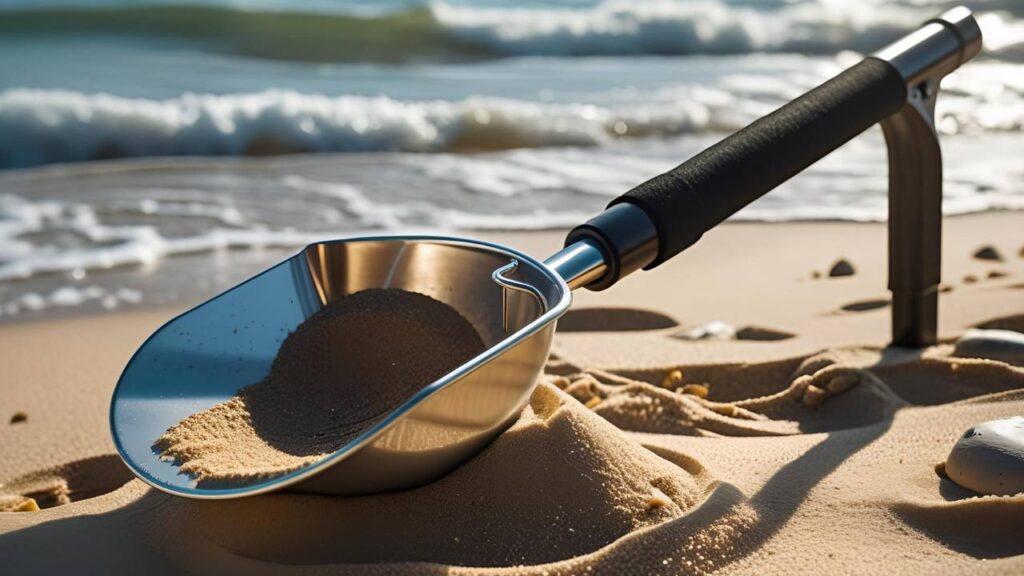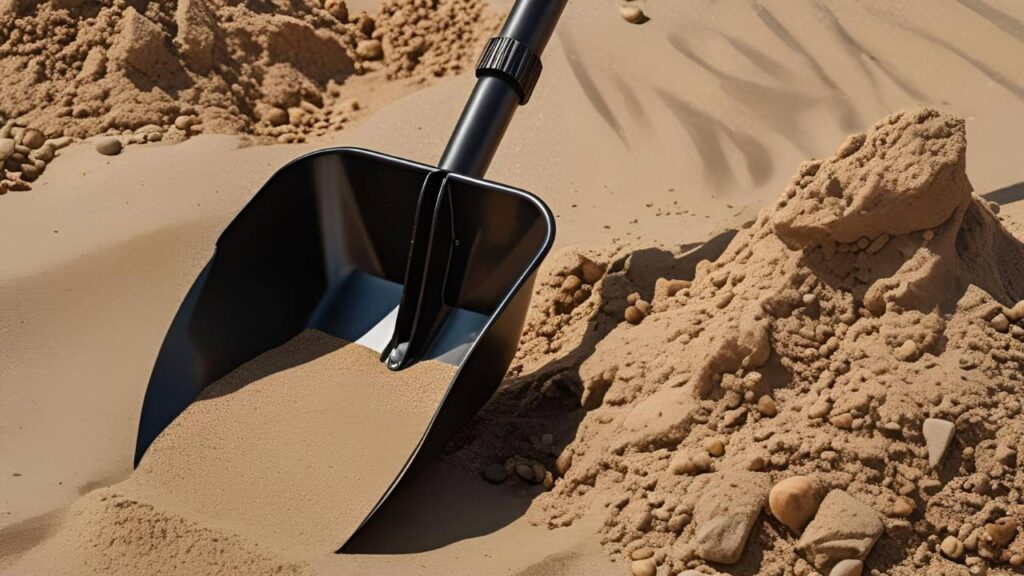Imagine your ideal companion for beach treasure hunting: a strong instrument that can handle loose sand and water. That is a sand scoop for metal detecting! This is not your typical garden shovel. Instead, it has a long handle (that may typically be lengthened) and a bucket or basket with holes in it at the end. When you put it in moist sand or shallow water, scoop up a load, then shake it quickly, that’s when the magic occurs. The sand flows easily through those holes that are put just so, leaving behind only the heavier things, like your gold band, missing currency, or antique relic. It makes digging that hurts your back and frantically sifting through your hands a smooth, quick operation. This lets you cover more territory and uncover more treasures without losing minor ones.

Why Metal Detecting Sand Scoop Matters
Ever tried digging a deep hole on a windy beach with just your hands? It’s frustrating, slow, and you’ll likely miss tiny targets. A dedicated sand scoop solves this. Its core job is rapid target recovery while minimizing damage to your find and the environment. The holes allow sand to vanish instantly, revealing items without them being scratched against rocks or shells. For water hunters in the surf zone, a robust scoop acts like an anchor, letting you dig effectively against waves and currents. Without one, you’re fighting the elements and wasting precious hunting time. It’s the difference between a fun, productive hunt and coming home empty-handed and sandy.
Essential Scoop Design Features
Not all sand scoops are created equal! Key features dramatically impact performance. First, the basket holes: Size matters! Tiny holes prevent sand from draining quickly, while overly large ones might let small jewelry slip through. Look for holes around 1/2 inch – perfect for draining sand but catching dimes and earrings. The basket shape is crucial too: pointed tips pierce compacted sand easier than flat fronts. Consider the handle connection: a sturdy, welded joint won’t snap under pressure like a bolted one might. Many scoops offer extendable handles – a lifesaver for deeper holes or avoiding constant bending. A comfortable grip and a wrist strap are also smart additions for long hunts.
Choosing Your Perfect Scoop
Picking the right sand scoop feels personal – it depends on your hunting style. Are you mostly in dry sand, wet sand, or surf? For dry sand, lighter aluminum or even tough plastic scoops work well. For wet sand and water, you need serious muscle: marine-grade stainless steel resists saltwater corrosion and handles pounding into dense, soggy ground. Think about size and weight too. A giant scoop holds more sand but is tiring to swing all day. A compact one is easier on your arms but means more scoops per hole. If you travel often, a travel scoop with a detachable or short handle is ideal. Balance your need for power with comfort!
Sand Scoop Materials Explained
What’s your scoop made of? It dictates durability and cost:
Stainless Steel (316 Marine Grade): The unchallenged saltwater and rough conditions leader. It laughs at rust and withstands brutal digging. Yes, it’s heavier and pricier, but it’s a lifelong investment for serious beachcombers.
Aluminum: A popular middle ground. Lighter than steel and decently strong for most dry and wet sand use. It is cheaper but can ultimately buckle under heavy pressure or rust in the salt water in case it is not washed thoroughly.
Plastic/Composite: Light as a feather & budget friendly, perfect for kids or for light dry beach use. However, they lack the strength for demanding wet sand or rocky areas and can crack. Stick to stainless for any serious water hunting!

Using Your Scoop Effectively
Mastering your sand scoop technique boosts fast! In soft dry sand, plunge the basket deep at an angle near your detector’s signal, lift, and shake vigorously side-to-side. For hard-packed wet sand, use your foot to drive the scoop tip down firmly – leverage is key! In shallow water, position the scoop basket downstream of the target signal before digging; the current helps wash sand away as you lift. Always dig a clean “plug”: insert the scoop cleanly, remove the sand, and replace it neatly afterwards – it’s good beach etiquette and prevents tripping hazards. Listen for the “clunk” of a target hitting the basket!
Maintaining Your Sand Scoop
By maintaining your sand scoop, it may last quite a number of years. After each hunt, especially after you have been in the saltwater, or in the mud, rinse it out thoroughly with fresh water. Salt is rather corrosive, and does not allow it to dry on the metal! On stainless steel scoops, a dab of little oil, like WD-40, on the joints and on the handle, is an added security every once in a while. Inspect the bolts or welds periodically to be sure that they are not loose or fractured.
Do not keep it in a hot vehicle trunk or a gear pit unless absolutely necessary; instead, store it somewhere dry. All you have to do is to wash it and check it once every few minutes, and this will prep it the next time you venture outside and save you the money on repair.
Top Sand Scoop Recommendations
Ready to invest? Here are proven performers:
Stavr Sava Pro (Stainless): A beast for surf hunters. Incredibly strong welded construction, sharp tip, and comfortable handle. Built to last forever in harsh saltwater.
CKG Sand Scoop (Stainless): Excellent value. Robust, well-designed basket, often with a great extendable handle system. Perfect for demanding wet sand work.
RTG Travel Scoop (Stainless): The go-to for portability. Shorter, often 2-piece design fits in luggage, yet still tough enough for serious digging.
T-Rex Aluminum Scoop: A solid, lighter-weight choice if you avoid heavy surf. Good hole pattern and durable for the price. Great for general beach use.
Difference Table
| Feature | Stainless Steel Scoop | Aluminum Scoop | Plastic Scoop |
| Best For | Saltwater, surf, hard-packed wet sand | Dry sand & wet sand (gentle use) | Dry sand only, kids, casual use |
| Weight & Feel | Heavier, super sturdy | Lighter, easier to swing | Lightest, minimal fatigue |
| Durability | ★★★★★ (Lasts decades, rust-resistant) | ★★★☆☆ (Strong but can bend) | ★★☆☆☆ (Cracks under pressure) |
| Price | Higher investment | Mid-range | Most affordable |
| Travel Friendly? | Heavy, some models break down | Better, still solid | Easiest to pack |
| Biggest Win | Unbeatable in tough conditions | Great balance for most beaches | Cheap & cheerful for dry sand |
Conclusion
Your metal detecting sand scoop is more than just a tool; it’s your best friend when it comes to finding buried gems at the beach. You may select the proper one and utilize it like an expert if you know the various designs, materials, and methods. A good scoop makes it easy to find anything, whether you’re sifting through dry sand for contemporary pennies or fighting waves for ancient artifacts. Make a smart investment in a sturdy design that works well in your hunting area. Take good care of it and learn how to do the digging shaking. Every signal becomes an exciting chance when you have the correct scoop in hand. Get ready to dig up your next great discovery!
FAQ’s
1. Why can’t I just use a regular shovel?
Ordinary shovels make holes but they do not sieve sands. The holes on a sand scoop allow the sand to run out in no time allowing you to discover tiny treasures such as coins or jewelry without excavating and sifting manually. It is a lot quicker and does not cause losing small finds.
2. Stainless steel or aluminum scoop – which is better?
It depends! The heaviest but also the hardest is stainless steel (and the marine grade is better), especially when it is saltwater, surf, and hard-packed sand. Aluminum is lighter and excellent in dry or wet sand as well; it could be damaged with a heavy hand and not the best option to be used full-time in saltwater. Make your choice depending on where you hunt more.
3. What’s the best sand scoop for a beginner?
Begin with a tough, mid-range stainless steel scoop, if you’ll be frequenting the beach. It deals effectively with both dry and wet sand and holds-up for years. If you’re on a shoestring budget and you’ll only hunt dry sand, consider a heavy-duty aluminum scoop which is a lot lighter. Steer clear of cheap plastic scoops.
4. Can my sand scoop handle digging in water?
Yes only if it’s made of marine stainless steel. This one resists salt water corrosion and is pliable enough to be bound into the seabed. There is no use in aluminum and plastic scoops for ordinary water fishing – they corrode, may bend or break under the pressure.
5. How do I make my sand scoop last longer?
It must be rinsed in fresh water after being used, more especially after salt water or mud! This prevents corrosion and rusting. Having a periodic inspection of bolts/welds to ensure that they are not damaged, and stainless steel joints cleaned with a soft oil (such as WD-40). Do not keep too hot in trunk of car, store dry. Easy treatment keeps it going through decades.
